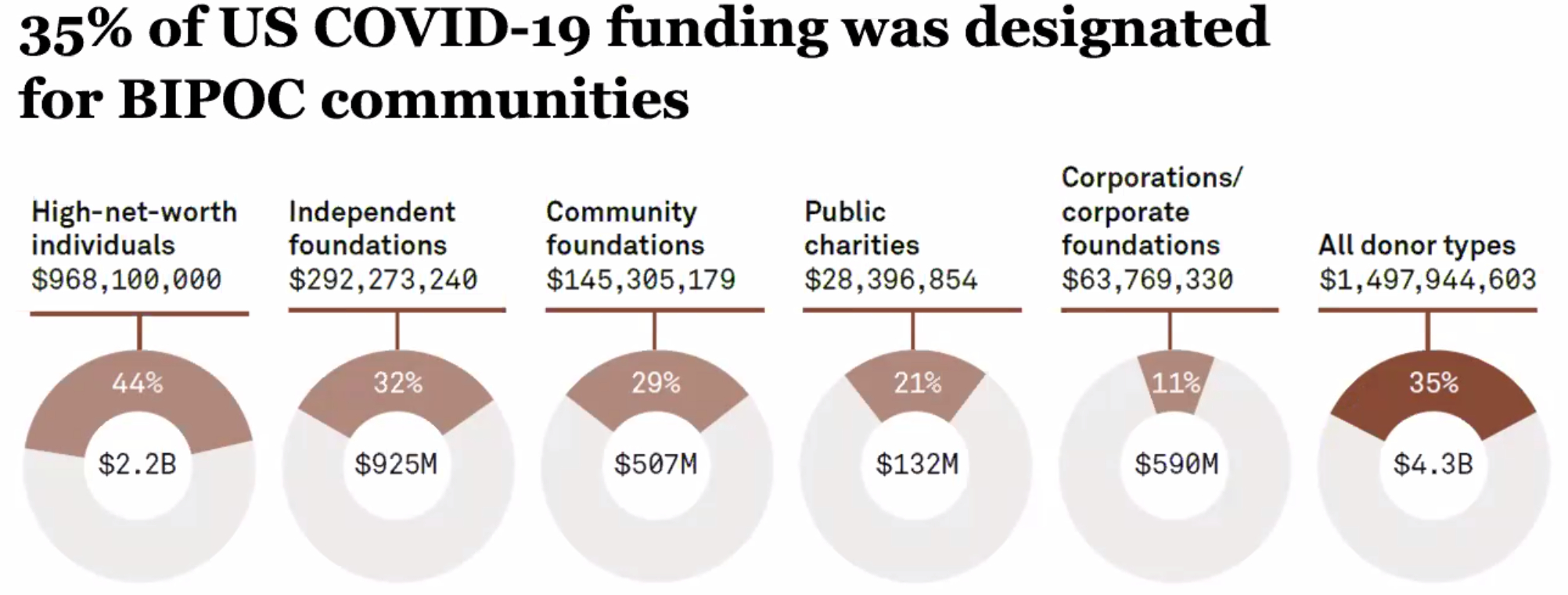What is Giving Compass?
We connect donors to learning resources and ways to support community-led solutions. Learn more about us.
Search our Guide to Good
Start searching for your way to change the world.
As the pandemic took hold in 2020 and exposed disparities across a range of systems -- including healthcare and education -- many communities and the nonprofits serving them struggled to stay afloat (nearly 930,000 nonprofit sector jobs had been lost by December 2020). As we move into a new phase of the pandemic with vaccinations ramping up, a new report looks at where philanthropy stepped up, where it fell short, and what donors can do differently moving forward.
In its latest report, Philanthropy and COVID-19 in 2020: Measuring One Year of Giving, the Center for Disaster Philanthropy (CDP) and Candid examined more than $20 billion in global philanthropic funding for COVID-19 efforts in 2020. On March 11 -- one year since the World Health Organization declared COVID-19 a pandemic -- CDP hosted a webinar to help donors understand the findings of the report.
Key Findings:
There were measurable shifts in how giving was conducted between the first and second half of 2020, although progress was still slow.
In the first half of 2020, unrestricted or flexible donations accounted for only 3% of the dollars identified as COVID giving in the report. In the second half of the year, that number was 39%. It should be noted, however, that philanthropist MacKenzie Scott’s $5.8 million commitment to social and economic justice causes accounted for this dramatic change. Without her contributions, unrestricted or flexible funding accounted for 9% of donated dollars. An anemic shift, given the discussions throughout the sector to increase unrestricted funding.
In more encouraging news, 35% of dollars was explicitly designated for communities of color or went to organizations serving communities of color. Although among donations from institutional donors, the share for communities of color was only 13%, an increase from 5% in the first half of 2020. Scott once again significantly contributed to this gap with her giving in the second half of the year.

Only 9% percent of COVID-19 dollars addressed policy and systems change. Post-COVID systems change was emphasized throughout the webinar as the key to recovering from the pandemic and preparing to meet future challenges.
Four percent of COVID-19 dollars was specifically directed to women and girls, which does not adequately address the ways in which women around the world are disproportionately impacted by the pandemic.
Questions for Donors:
In response to this information, individual donors and institutional philanthropy alike have the opportunity to reflect on core questions about the future of giving raised by the panelists including:
- Will donors truly share power?
- Will the shift toward giving best practices -- including swift, trust-based grants, and unrestricted funding -- continue, stall, or regress?
- Will BIPOC communities and women receive a share of dollars that reflects their disproportionate disadvantages?
- Will funding materialize for systems change to address the underlying inequalities that exacerbated and were exacerbated by the pandemic?
- Will donors invest in long-term recovery or will interest and dollars wane as the pandemic does?
Every donor - of any size and working in any issue area - should be thinking about how their individual giving choices will shape the future of philanthropy, COVID-19 recovery, and preparation for disasters to come. The panelists offered donors specific advice for shifting power and achieving systems change including:
- Using a race and gender equity lens for funding.
- Providing more unrestricted, flexible grants to enable recovery.
- Focusing on long-term reimagining and restructuring efforts in addition to relief.
- Targeting root causes of issues.
- Engaging in cross-sector collaboration.
- Exploring community-driven philanthropy.
- Building on existing experience and solutions based on data.
Watch the full webinar and access the report at The Center for Disaster Philanthropy to learn more.
Categories:
- North America
- Disasters
- Philanthropy Research
- COVID-19